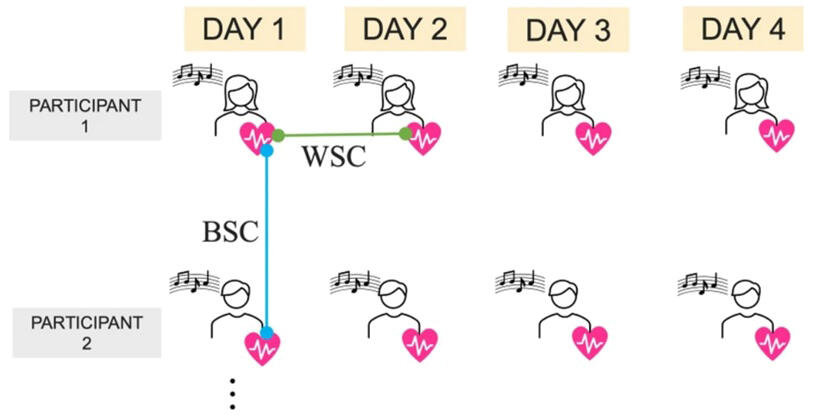Recent research has found that audiences at live music concerts synchronize their physiological states, and Associate Professor Ryota Nomura of Waseda University's Faculty of Human Sciences announced that he has worked out the related mechanism. Nomura and his group conducted an experiment in which participants repeatedly listened to music every few days. The experiment showed that heart-rate data obtained from the same participant was more synchronized than that obtained from different participants. The results, published in the international journal Scientific Reports on May 28, are expected to improve the reproduction of the audience members' emotional experience through theaters and viewing devices.

Nomura, R. Reliability for music-induced heart rate synchronization. Sci Rep 14, 12200 (2024).
https://doi.org/10.1038/s41598-024-62994-0. CC by 4.0
In the theater, similar emotions simultaneously arise among the audience, creating a strong sense of unity. It has been believed that such collective emotions are due to the phenomenon of synchronization, whereby the physiological states of multiple spectators viewing the same stage performance align. Advances in measurement technology have led to an increasing number of reports on field-sensing data analysis to measure human behavior data in natural settings, including theaters. On the contrary, many studies only reported synchronization of time-series data such as individual heartbeats, skin potentials, and electroencephalograms. The mechanisms of correlation among audience and synchronization of behavior in the auditorium were unknown.
The research group based their approach on the theory of nonlinear dynamical systems, a branch of physics in which the state of a system at a given time is complexly determined by the state of the system at an earlier time. They theoretically predicted that audience would synchronize with each other through a mechanism called "common input synchronization" (whereby a common input synchronizes the states of multiple systems). These theoretical predictions were confirmed by empirical experiments. Experiments were conducted on individuals, eliminating the interaction between the audience present in the theater. The research group aimed to clarify the magnitude of the effect of the common input of "music" in synchronizing heartbeats.
"Consistency" is a concept in nonlinear dynamics. It refers to the phenomenon in which systems with different initial states are given the same complex input signal and observed to initially produce different outputs, but subsequently produce identical outputs. From this perspective of consistency, a performance shared by audience can be viewed as synchronizing their physiological state, regardless of their initial state (e.g., mood or physical condition on the day).
In the experiment, the participants were asked to listen to a common piece of music, the "assigned piece," and a "free piece," which the participants named as the most moving piece of music they had ever heard. The pieces of music were played in random order, four times every 2 to 7 days. The participants responded using a psychological scale to describe their mood just before and after listening to the music. Additionally, correlations were calculated for single individuals (e.g., the same individual on Day 1 and Day 2) and between individuals (e.g., on Day 1 for different individuals).
Results indicate that the intra-individual correlations were consistently higher than the inter-individual correlations for the assigned and free pieces. While some mood changes before and after listening to the music were positive, synchrony was not predicted by how similar people's moods were before the experiment.
These results suggest that heart rate synchronization does not depend on the motivation or mood elevation by listening to music, but on the reliability of how the music is processed in the brain to produce a physiological response. If mechanisms can be built to increase the reliability of response to audience input, it may be possible to reproduce the excitement of the theater with a high degree of reliability. For example, designing theater environments and affording assistance by means of viewing devices to unfailingly respond to inputs can help enhance audience synchronization and make performances more enjoyable. The research group will empirically clarify how audience interaction facilitates common input synchronization and the strength of its influence in future studies.
Nomura said, "You may be surprised to hear about empirical research on theater spaces, but recently, research on live performance has been conducted worldwide. In this study, our experiment revealed one aspect of the mechanisms of synchronization among audience. A theater space where emotions are 'replayed' is an ideal experimental system to reveal human synchrony. In the future, we plan to analyze data obtained from actual theaters and shed light on the complex and intricate interactive relationships between performers and audience groups."
Journal Information
Publication: Scientific Reports
Title: Reliability for music-induced heart rate synchronization
DOI: 10.1038/s41598-024-62994-0
This article has been translated by JST with permission from The Science News Ltd. (https://sci-news.co.jp/). Unauthorized reproduction of the article and photographs is prohibited.




